Although world-renowned today for its iconic 16th century Galle Fort, the Galle city has an ancient reputation of being a vibrant economic hub along the Silk Route. Its prosperity is described in Sinhala literature from the 14th and 15th centuries AD. The Moroccan explorer Ibn Battuta recalls in his writing his amicable visit to the city of 'Qali', which is the 14th century version of Galle.
Furthermore, the Galle Trilingual Inscription dated 1409 is archaeological proof of Sri Lanka's ancient relations with neighbouring empires. This majestic stone slab was brought to Sri Lanka by the Chinese admiral Zheng He, and records, in Chinese, Persian and Tamil scripts, the benevolence of the Chinese Ming Dynasty towards Sri Lanka.
Several centuries after Battuta and Zheng He, the British Colonial Secretary to Ceylon, Sir James Emerson Tennant speculated that Galle may be the city of Tarshish mentioned in the Bible, whence Israel obtained gold, silver and other valuables during the reign of King Solomon.
Today, Galle promises everyone much to see and do.
In this article, I will take you through this mesmerizing city, highlighting 10 things to do in Galle. I will guide you along the strong ramparts and paved lanes of the Galle Fort to its museums, churches, temples and other landmarks, and then head to the city's emerald coastal stretch. Finally, this article explores options to connect your Galle trip with wildlife and nature hotspots within our island of Sri Lanka.
1. The Galle Fort
The Galle Fort never fails to fill me with awe; it is like a treasure map quilled on parchment. It is a lived-in UNESCO World Heritage Site that amalgamates the Western, the local, the ancient and the modern. This time capsule enthralls the visitor with its old ochre-walled buildings, cobblestone pathways and colonnaded verandahs.
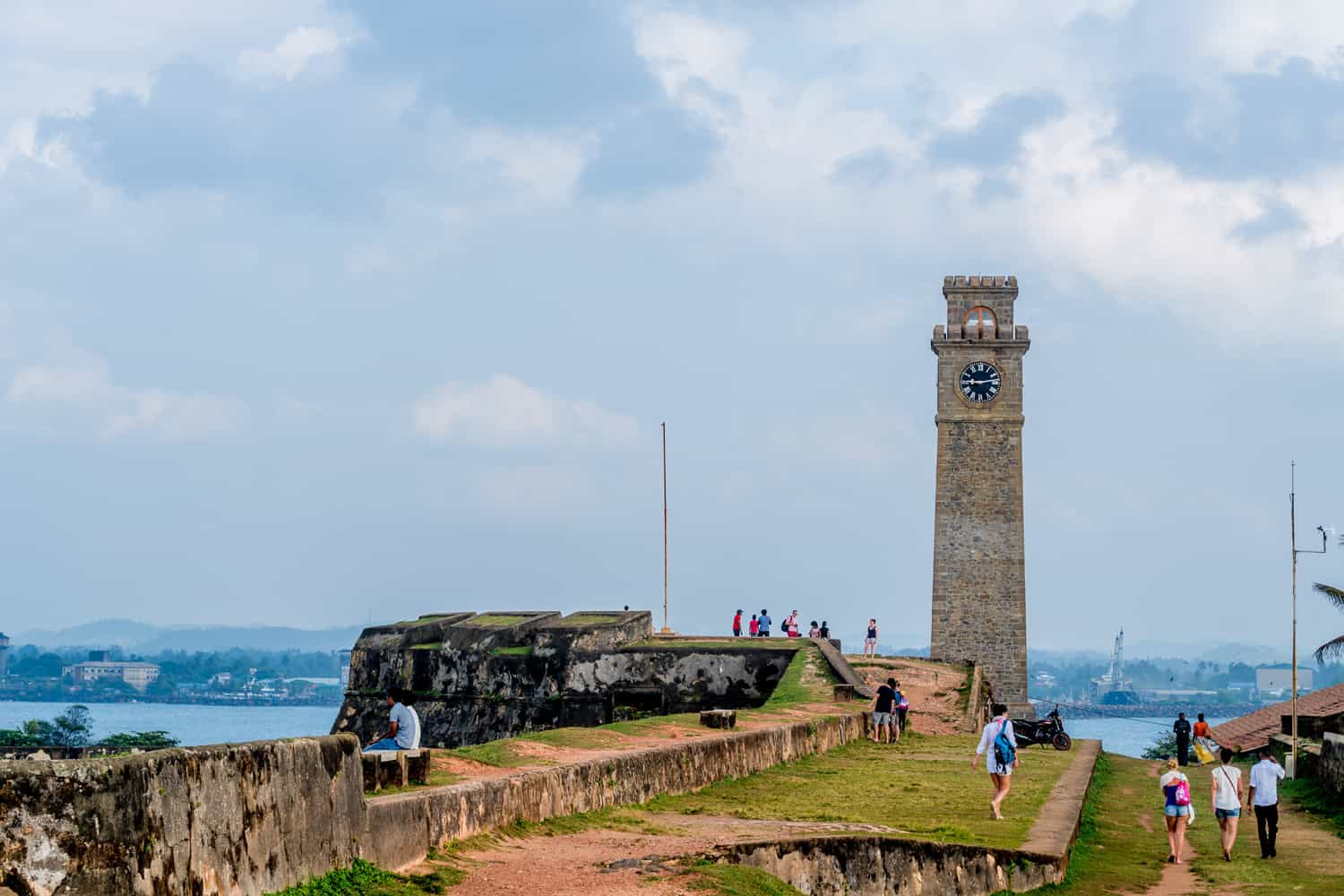
The fort covers a land area of 30 acres. Its periphery is marked by the olden Portuguese- and Dutch-built ramparts. Along the ramparts are 14 bastions, which are points where the ramparts project towards the fort's exterior. Some of these bastions are still armed with cannons poised towards land and sea, and they loom haughtily over the Galle Bay to the east, the Indian Ocean to the west and south, and the mainland towards the north.
The Galle Fort ramparts on which wars were waged are now peaceful and conducive to you enjoying the murmur and breeze of the sea against the purple and orange sunsets of Galle.
Two entrances to the Galle Fort
The Galle Fort has two entrances, each memorable in their own right. If you enter through the Main Gate, also known as the British Gate, you will pass under an ancient arched tunnel which is as long as the ramparts above it are wide!
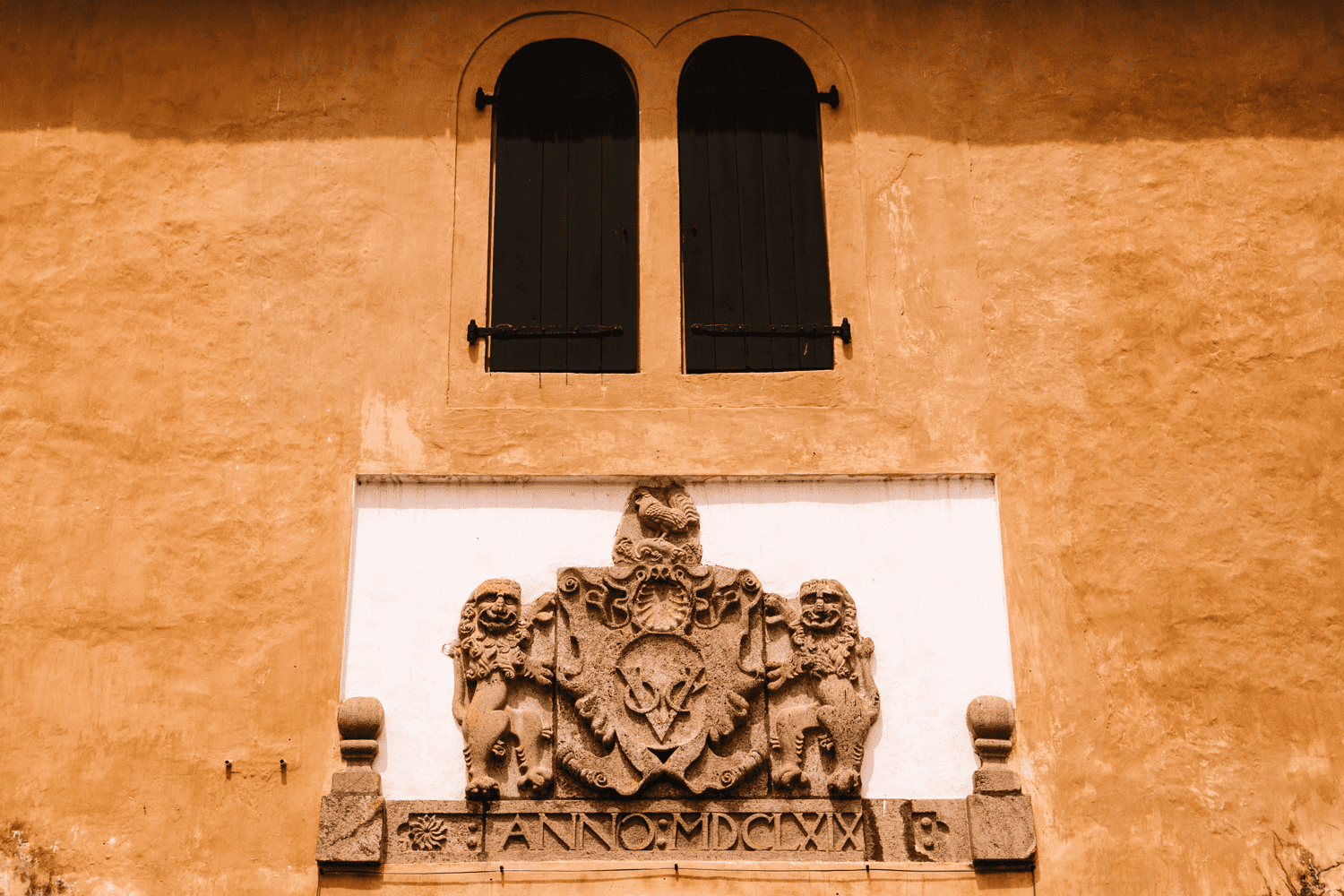
Towards the east of the fort lies its second entrance, the Old Gate (or Dutch Gate) displaying on either end of the tunnel two colonial emblems.
As you enter through this tunnel, make sure to glance up at the British emblem that crowns the arch of the gateway. It stands as it did in the days gone by, with the Latin phrase Dieu et Mon Droit (God's and My Domain) as its motto.
On the inner side of the entrance is the Dutch coat of arms displaying the letters VOC. This acronym stands for Vereenigde Oostindische Compagnie, meaning the Dutch East India Company.
As I am easily enthralled by history's mysteries, I feel that these emblems symbolize the rise, clash and fall of empires. I am reminded of Samuel Johnson's description of those "athirst for wealth": "they mount, they shine, they evaporate, they fall"!

Would you like a Sri Lanka trip like Beatriz's?
We had the pleasure of assisting Beatriz's family on their two-week holiday in Sri Lanka, and they absolutely loved it. Would you also like a hassle-free family holiday? Please drop us a message specifying your requirements, and we will get back to you with a tailor-made Sri Lanka tour package within 24 hours.

Would you like a Sri Lanka trip like Beatriz's?
We had the pleasure of assisting Beatriz's family on their two-week holiday in Sri Lanka, and they absolutely loved it. Would you also like a hassle-free family holiday? Please drop us a message specifying your requirements, and we will get back to you with a tailor-made Sri Lanka tour package within 24 hours.
A Maritime Museum in an old Dutch Warehouse
The Old Dutch entrance intersects an elongated colonial construction which, during the 17th century Dutch rule, was the largest warehouse in Asia. In its heyday, it was packed with spices like cinnamon and a range of other products to be traded by the colonizers around the world. Built in the 1670s, this ochre-walled building stretches between the Zwart and Commandment bastions. Today, it is home to a maritime museum.
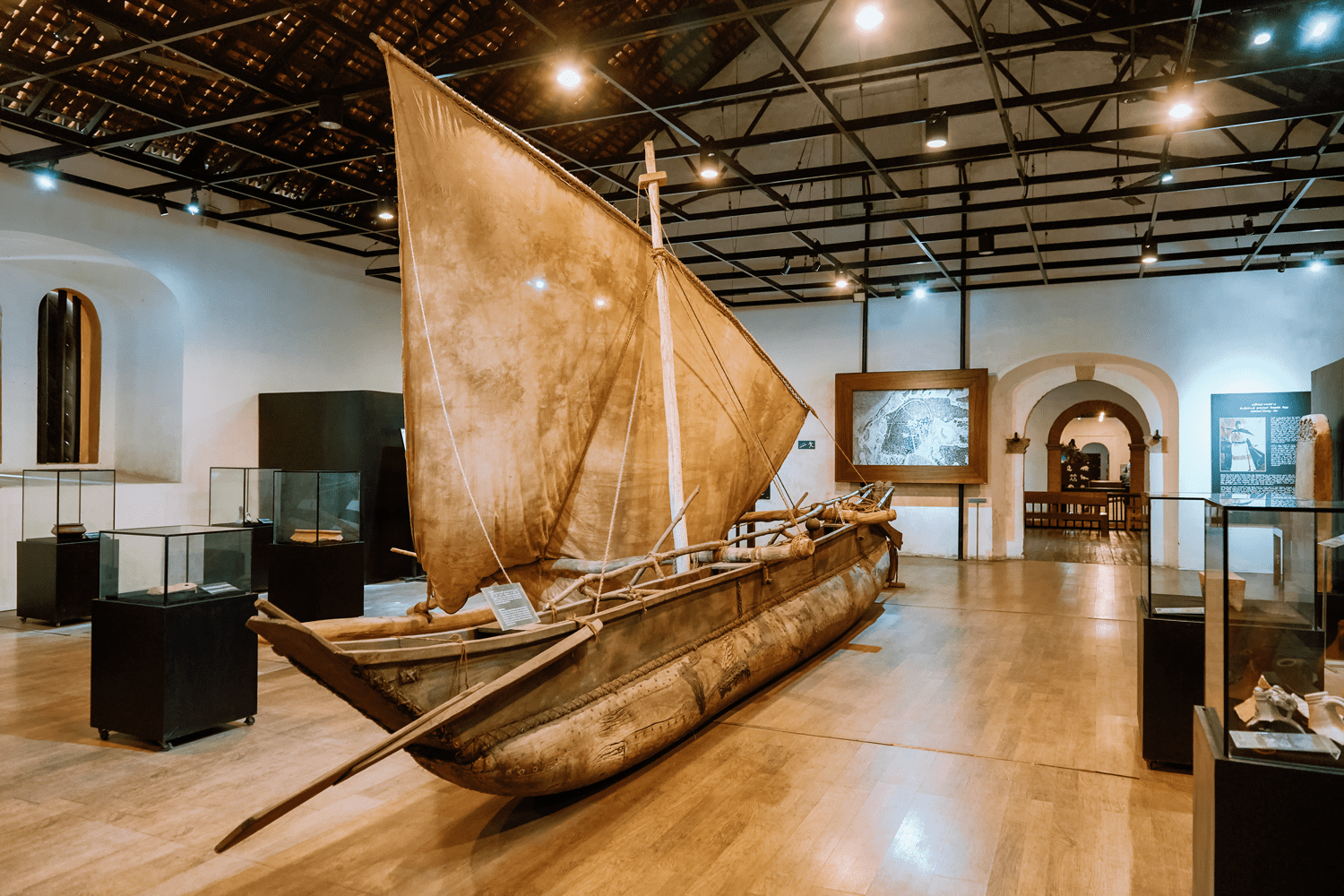
The Galle Maritime Archaeology Museum is Sri Lanka's first of its kind. Declared open in 2010, its four galleries display various artifacts that were salvaged from the depths of the ocean by the Maritime Archaeological Unit. The Hercules Bell, which is dated 1625, once belonged to the Dutch ship named Hercules. The old Chinese porcelain at this museum is evidence of the relationship that Sri Lanka has had with China over the centuries. My personal favourite from among all of these antiques is the granite bench from the Godawaya shipwreck, the oldest wreck site in the Asia-Pacific region. This wreck is believed to have slumbered undisturbed on the lonely seabed from the 1st century AD until its discovery in 2003.
The Zwart Bastion: where the colonizers first set foot
Within a short walking distance from the Museum is the Zwart Bastion, which marks the starting point of Sri Lanka's colonial history. The Portuguese explorer Lourenço de Almeida is believed to have made first contact with the island at the old pier that protrudes from this bastion towards the Galle bay. His infamous arrival precipitated on our island a centuries-long era of colonial domination.
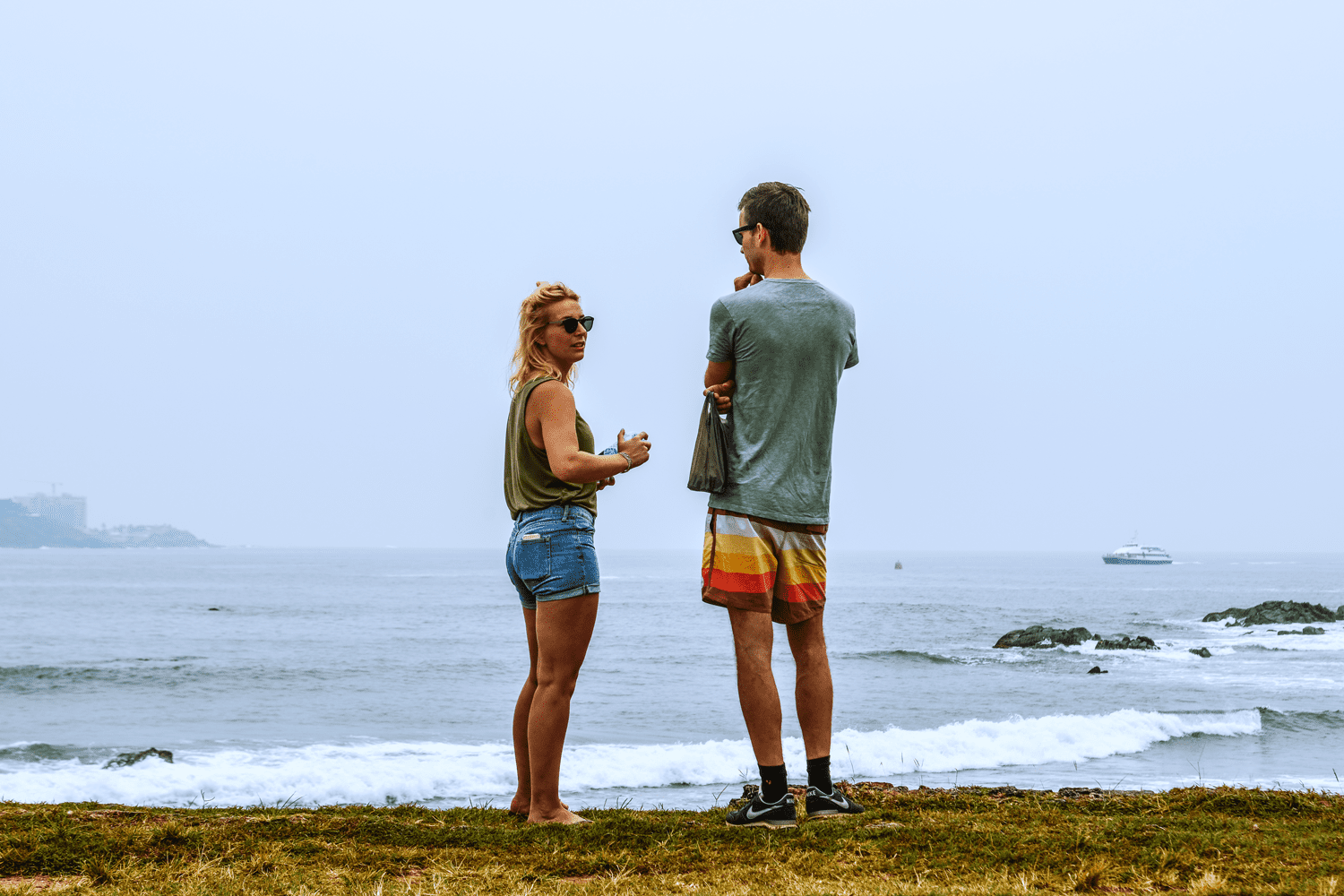
Today, in its large, shady, open-air terrace, you can enjoy the sea breeze heading from the Galle Bay as you enjoy views of the green skyline of the Galle district.
Originally called Fortaleza and Santa Cruz by the Portuguese, this bastion is the oldest of the fort's fourteen bastions. This structure dated 1588 is now home to the ruins of a gunpowder magazine, prison cells, and blacksmiths' workshops. The smoke from these smithies blackened the walls of the bastion, which made the Dutch rename it as the Zwart (Black) Fort.
The Galle Fort Ambalama in the Courts Square
Outside the entrance to the Zwart Fort is the Galle Fort Ambalama within the Courts Square.
The Sinhalese word ambalama roughly means wayfarers' resting place. Dating back to the mid 16th century, it consists of a tiled roof balanced on four cylindrical columns. Over centuries, this ambalama would have provided shelter to the travellers who came that way. You too can stand in its tree-shaded shelter, on your strolls within the Galle Fort.
The Akersloot Bastion
A short walk along Hospital Road away from the Zwart Fort entrance brings you to the 1759-built Akersloot Bastion. Named after the birthplace of the first Dutch Governor of Ceylon, Willem Jacobzoon Coster, this bastion offers views of Roomassala and Unawatuna which are at the opposite end of the concave of the Galle bay.
The bastion offers you excellent vistas of the Galle Harbour which you can enjoy in the shade of a breadfruit tree. This tree is believed to be the first of its variety to have been planted in Sri Lanka by the Dutch.
The Old Dutch Hospital
Adjoining the Akersloot Bastion is the Old Dutch Hospital, which, back in the day, fulfilled the medical requirements of employees of the Dutch East India Company and Dutch soldiers. Believed to have been built in the 1680s, this building is complete with verandahs that run the length of the former medical wards.
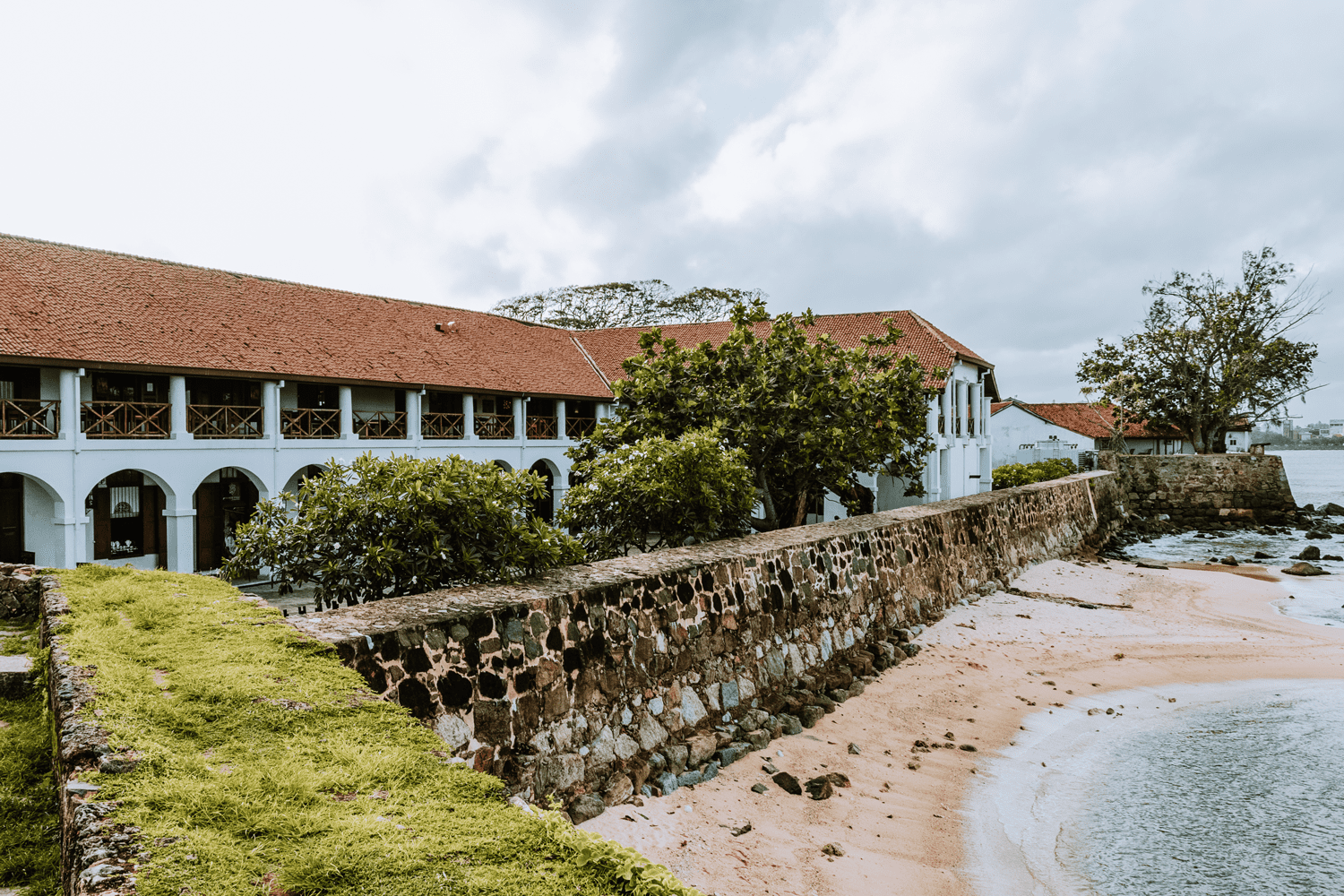
The Dutch Hospital was renovated in 2011 and is now a shopping and dining precinct. It is the ideal location for your Galle shopping spree topped by a scrumptious meal and gorgeous view of the Galle Bay.
The Aurora Bastion
The cobblestone Hospital Street leading away from the hospital building passes the Aurora Bastion on the left before it runs towards the Galle lighthouse.
The Aurora Bastion was so named to mean the bastion where the rays of the dawning sun first light up the Galle Fort. This bastion is beyond doubt the best place to view the sun rising over the Galle bay.
On the shores of the Aurora bastion is a Second World War bunker installed by the British in 1943. The layers of history of the Galle Fort are mesmerizing!
The Galle Lighthouse on Point Utrecht Bastion
Further down Hospital Street, on the Point Utrecht Bastion, stands the Galle Lighthouse. This 85 ft structure has been gazing, since 1939, towards the entrance of the Galle Harbour and the horizons of the Indian Ocean like a silent one-eyed sentinel. The light it emits travels for approximately 40 km.
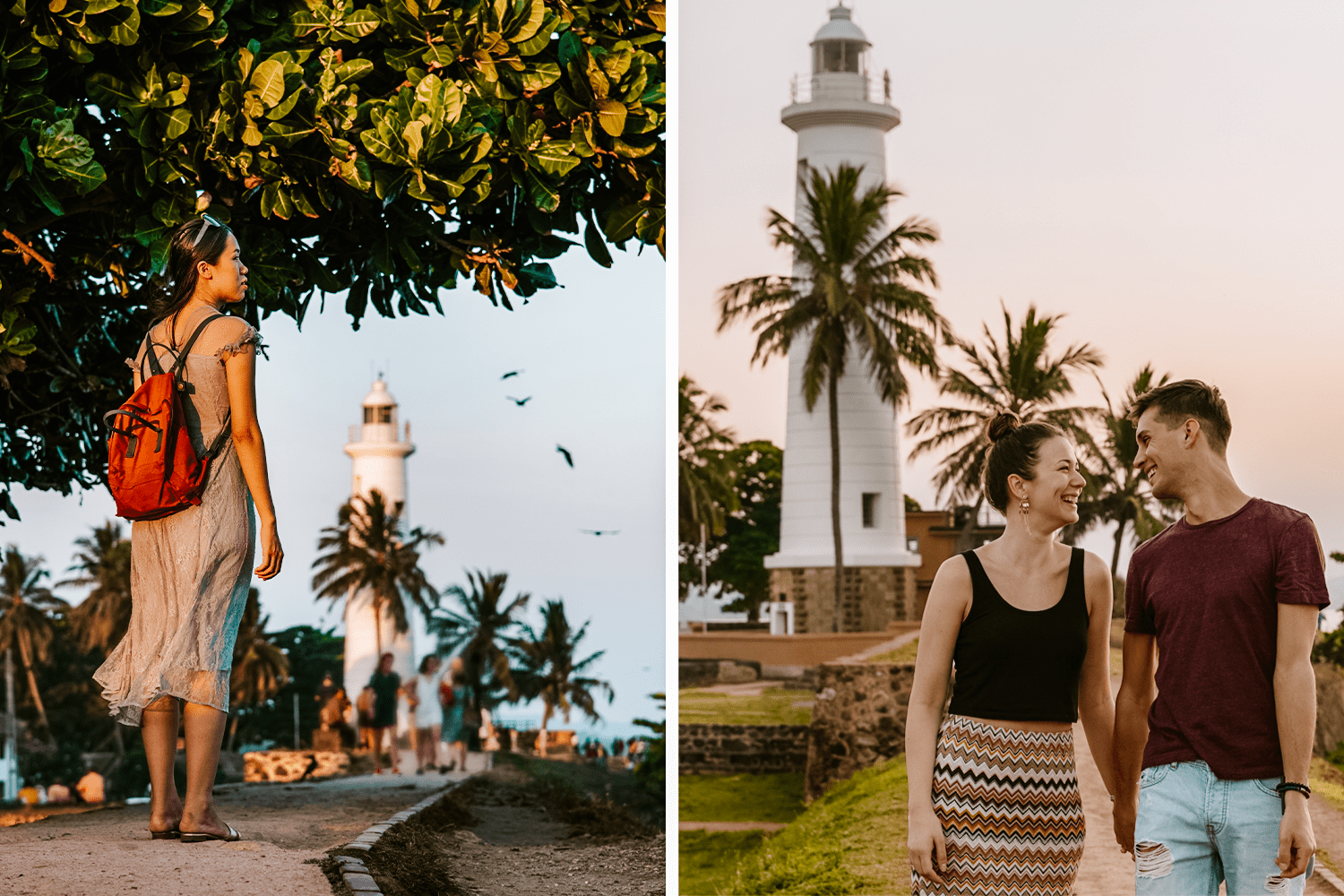
From this bastion, you can easily access a part of the fort's sandy shores which is a favourite swimming beach among both local and foreign tourists.
Flagrock Bastion
Close to the Utrecht Bastion is the Flagrock Bastion. It stands on a rocky promontory which opens to you vistas of the teal and royal blue hued Indian Ocean!
Within the bastion, you can see remains of the foundation of Sri Lanka's first lighthouse which was destroyed by a fire in the 1840s.
During the Second World War, a British cannon was mounted on the bastion, ready to shoot any enemy aircrafts that vied to enter the Galle Fort airspace.
Opposite this bastion, facing the Indian Ocean, is the pearly white Meeran Jumma Mosque which was built in the 1900s. Its architecture is a combination of Victorian and Islamic design. Visiting the mosque requires close adherence to the rules of the mosque, one of them being modest attire.
The Bastions on the Fort's West
A short walk from the Flagrock Bastion is the Triton Bastion which is the first of the bastions that look towards the west of the fort. Here, you can see the foundation of a rotating cannon installed by the Dutch to protect the fort from enemy navigators.
The Rampart Street takes you from the Triton to the Neptune Bastion, where you can see the ruins of the Lloyds Naval Signal Station. In its heyday, this station conveyed navigational signals to passing ships through the flag hoisting technique.
The other two bastions on the western coast of the fort are the Clippenburg and Aeolus Bastions. Located in a relatively quieter part of the fort, fringed with grassland, these bastions offer fantastic views of the ocean and are ideal for an evening stroll.
In close proximity to the Clippenburg bastion, the Sri Sudharamalaya Buddhist temple is evidence of the colonial architectural influence on religious buildings within the Galle Fort. This temple is home to a stupa that was built in the late 1880s. The temple's column archways and belfry suggest that this building may have been a church in the days gone by. Today, along with the colonial churches and the Meeran mosque, the Sudharamalaya Temple is evidence of the harmony that exists in the multireligious community that lives within the walls of the Galle Fort.
When at the Aeolus bastion, you might be expected to exercise care as the Sri Lanka Army Camp is located nearby.
The northern bastions and the Galle Clock Tower
Today, at the north side of the fort are the Star, Moon, Sun and Fishmark bastions, built by the Portuguese and later renovated and renamed by the Dutch and British. These fortifications were used by the European colonizers to protect themselves against attacks from the natives of Seethawaka, which was one of the kingdoms of the island at the time.
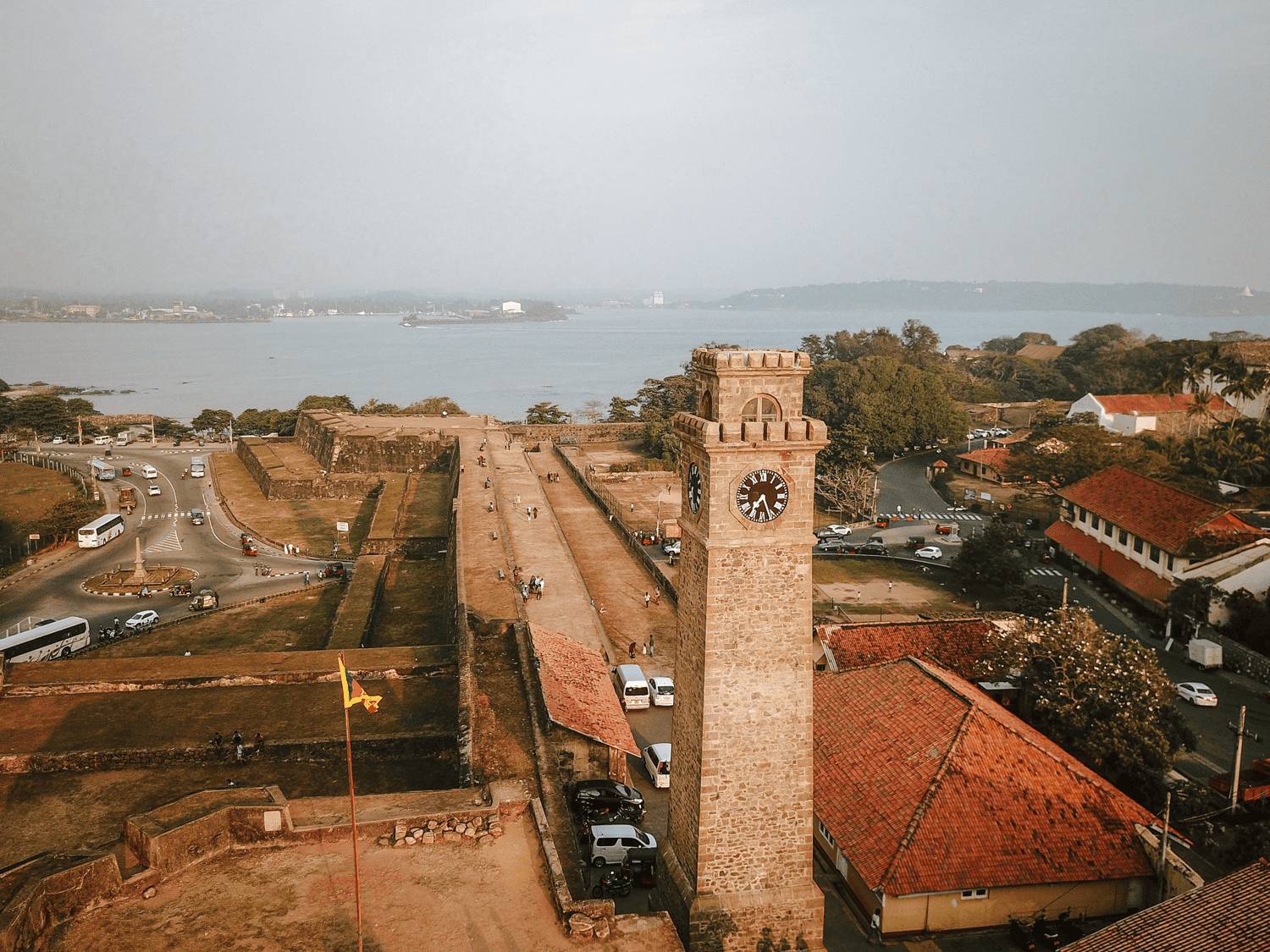
The Galle Clock Tower, one of the city's most iconic landmarks, is located on the Moon bastion. Standing at a height of 25.3 m, this structure was built in 1883, memorializing Dr. P. D. Anthonisz, the first Sri Lankan to graduate with a medical degree from a British university. The clock tower also overlooks the Galle International Cricket Stadium which is just outside the Galle Fort and dates back to the 1870s.
Some Historical Landmarks at the fort's center
Along the fort's cobblestoned Church Street, within walking distance from each other, are the Galle National Museum, the Dutch Reformed Church (also known as the Groote Kerk) and the Galle Library.
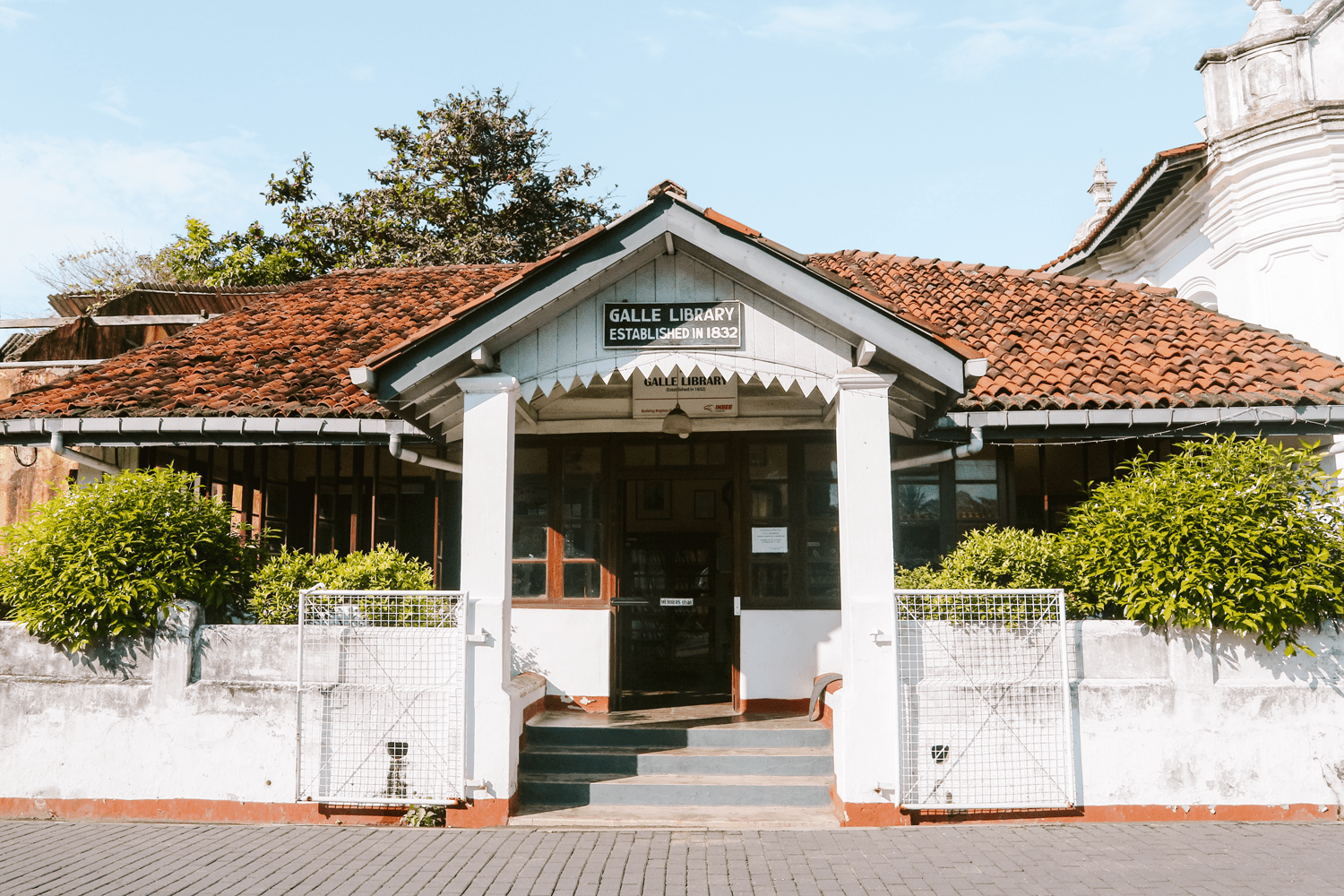
Declared open in 1986, the Galle National Museum is housed within an old Dutch building constructed in 1686. It has three galleries, the first one of which displays items related to the Southern Province of Sri Lanka while the second gallery showcases artifacts from the three colonial eras of Sri Lanka. Gallery No. 3 is dedicated to historical evidence of the relationship between Sri Lanka and China.
A few meters away is the Groote Kerk, which was constructed in 1755. It is one of the oldest Protestant churches that are still in use in Sri Lanka today.
The church is 12 m above sea-level and is located at the highest point within the Galle Fort. Its construction was funded by Casparus de Jong, the Commandeur of Galle, as a sign of gratitude for the birth of his long-awaited daughter.
Today, the church is of immense historical and archaeological value. The tombstones that pave part of the church floor and the ancient pipe organ are just a few of the colonial artifacts that can be witnessed within the church.
Right next to the Groote Kirk is the Galle Library which was established in 1832. This library is believed to be the oldest public library in the island. It is housed in a quaint, single-storey construction that dates back to the era of Dutch rule.
Today, it is home to about 8000 books, written in a variety of languages. Some of its prized publications are Robert Percival's An Account of the Island of Ceylon (1803) and James Cordiner's Description of Ceylon (1807).
2. Snorkeling around Galle
Adorned with vibrant coral reefs and marine life, the shallow waters of the Galle Bay promise you a memorable snorkeling experience!
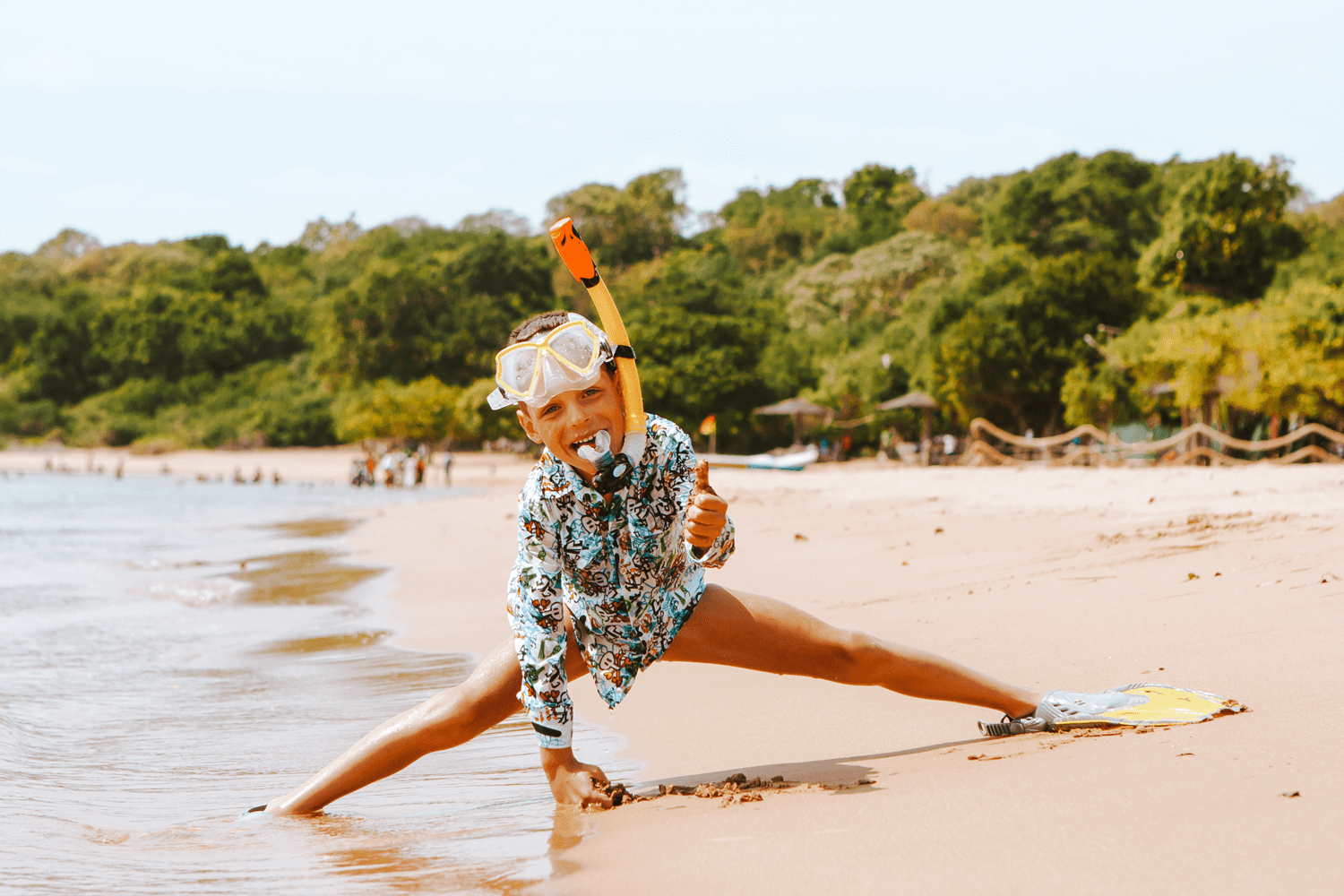
A few of the most famous snorkeling locations accessible from Galle are the Jungle Beach Bay, Unawatuna Bay and Hikkaduwa. The Unawatuna Beach is also conducive to a safe and fulfilling ocean swim. So, make sure to don your swimming gear, snorkeling masks and fins to delve into life below the sea surface along the Galle coast line.
The ideal time of year for your swimming/snorkeling adventure in Galle is from November to April, when you can make the most of the sun, blue skies and ocean breeze!
3. Surfing in and around Galle
Glide along and ride the green and white ocean waves in Galle and Hikkaduwa! Along this stretch of the south-western coastline are many beach, point and reef breaks, and the waves cater to both novice and expert surfers.
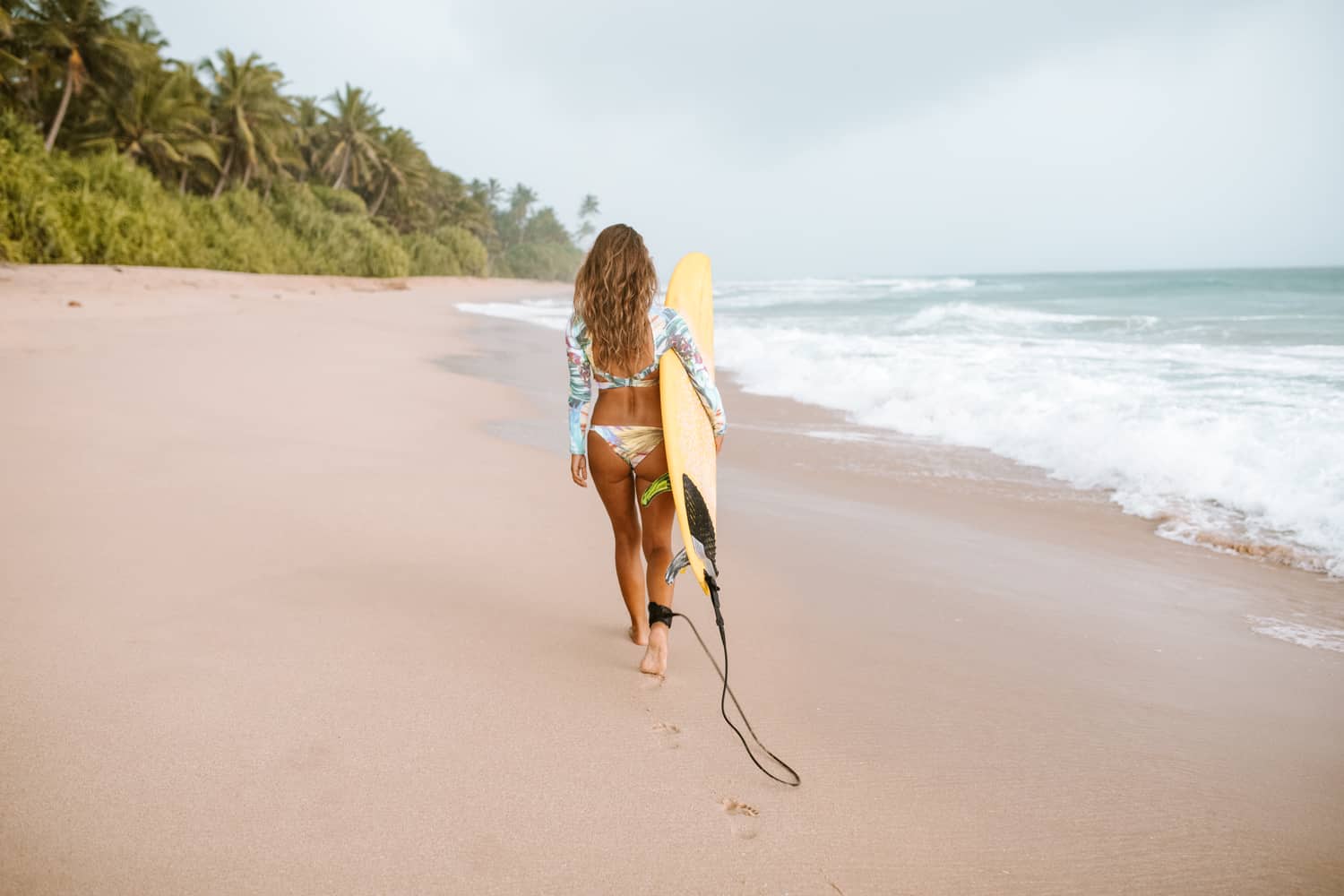
Some popular Galle and Hikka surfing locations are the Dewata beach, Narigama beach and Owakanda. However, our expert tour guides recommend Weligama, a surfing spot known for its beginner waves and lengthy beach break, for a more wholesome Sri Lankan surfing experience! Weligama is situated further down south along the southern coast, less than an hour away from Galle!
The best time to surf in any surfing spots in and around Galle is from November to April.
4. The Galle shopping experience
Enjoy a shopping spree in the boutique stores sheltered in the quaint colonial mansions of the Galle Fort. These shops sell a wide range of items like clothing including kaftans and scarves, along with paintings, ornaments, artwork, gems, jewelry, handwoven items and even designer and antique furniture!
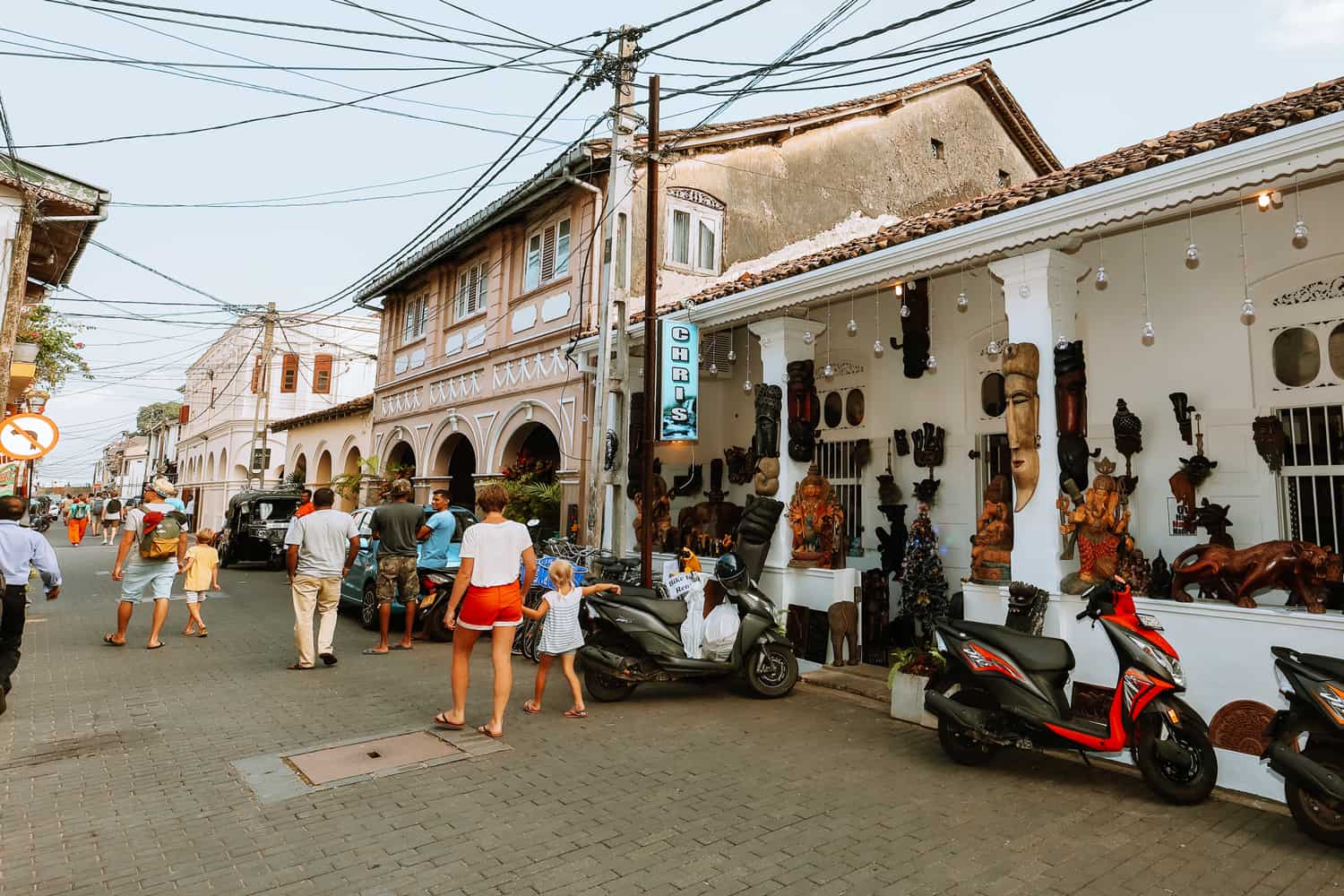
Speaking of handwoven products, you have the opportunity to tour a weaving factory, where locals sit at weaving frames and blend their handicraft skills with vibrant warp and weft strands to create brilliant handloom fabric!
5. Unique dining in a historical ambience
Dining at a boutique restaurant in Galle is a must; the reasons are threefold. Firstly, restaurants in Galle are popular for their delicious seafood. Also, their menus blend Sri Lankan tastes with Western and other Asian cuisines: you can choose between the local hopper, string hopper and godamba roti or opt for a burger, pizza or sashimi! Finally, Galle restaurants, especially the ones within the Galle Fort, are housed in ancient, colonial constructions, thoughtfully renovated and refurbished to compliment your dining experience in a uniquely historical ambience!
6. Stilt fishing
You may have seen stilt walking around the world, but stilt fishing is exclusively Sri Lankan! So, it is of little wonder that the image of fishermen patiently perched atop wooden stilts, their silhouettes like one-legged storks against a purple horizon, have now come to symbolize Sri Lanka!
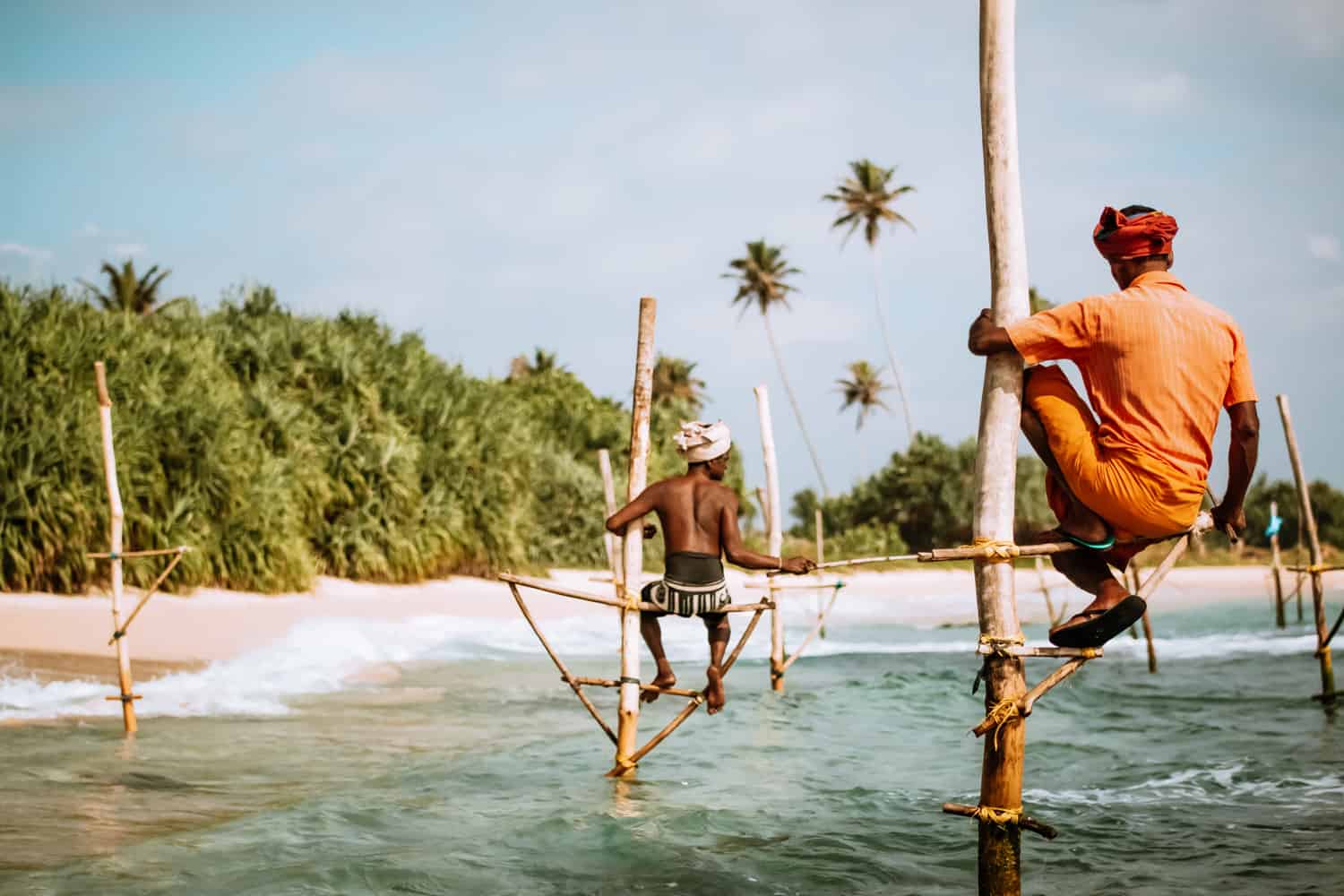
Practiced especially in areas along the southern coastline of the island, stilt fishing is believed to date back to World War II.
When in Galle, make sure to witness this unusual fishing custom. For a small fee, you will be able to take snapshots of the stilt fishers or even pose for Insta-worthy photographs of you giving your first try at this unusual fishing technique!
7. Turtle Hatcheries in and around Galle
Make sure to include in your Galle itinerary a stop at a turtle hatchery. Sri Lanka is home to five turtle species, including the critically endangered Leatherback and Hawksbill varieties and the environmentally vulnerable Olive Ridley turtle. So, to protect these species that have neared extinction, the Sri Lankan coastline is dotted with turtle hatcheries, with the most famous of them located in and around Galle.
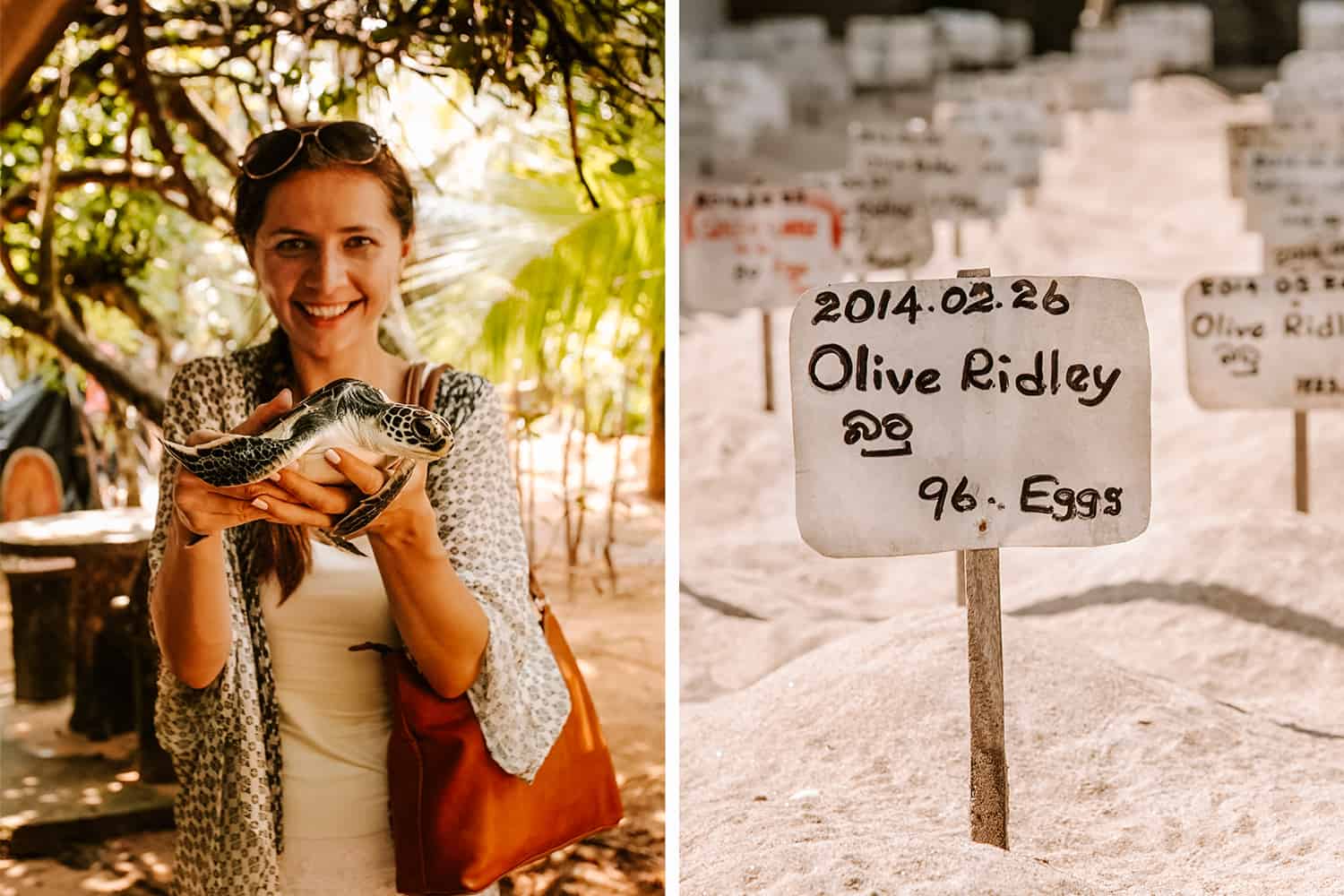
These hatcheries watch over turtle eggs in their incubation period as well as provide a space for wounded turtles to recuperate. They also look after permanently disabled turtles that are handed to the hatcheries by concerned and well-meaning individuals.
My favourite sight at these turtle hatcheries is the newborn turtles clumsily paddling their way across tanks with their fore and hind flipper-like feet!
If you are visiting Sri Lanka with kids, a stop at a hatchery is a must and definitely would be a highlight in your Sri Lanka trip.
8. An evening boat ride along Madu River
Embark on yet another exciting adventure on your Galle trip by dropping by at Madu River for a boat trip! The best time to enjoy this tour would be in the mild evenings, when the harshness of the sun is past and the water surface reflects the evening sky.
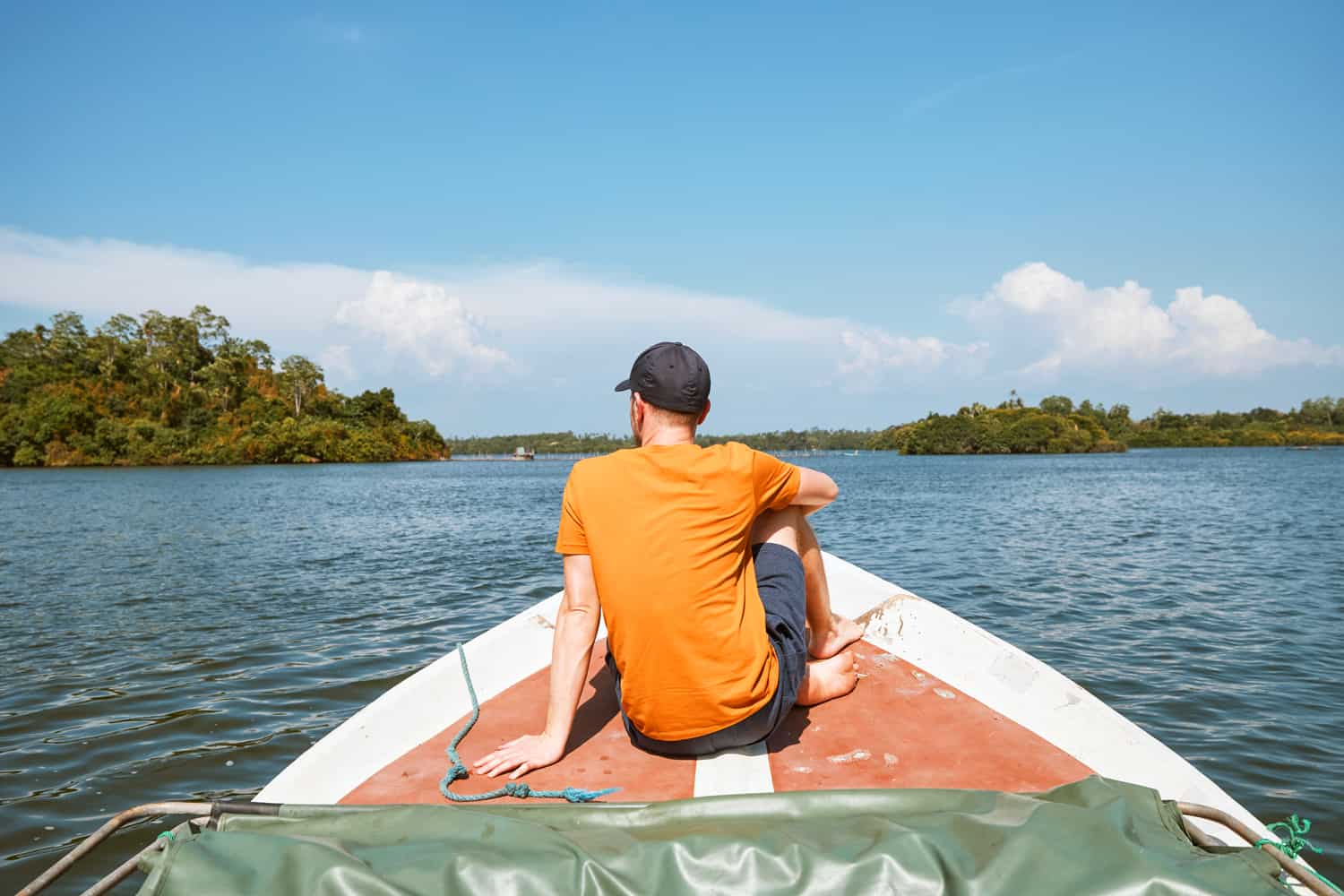
A typical boat tour takes you along this giant waterbody, transporting you across clumps of mangroves from island to island, which have their unique importance.
On the Kothdoowa Island (Doowa means island in Sinhalese.) is the Kothdoowa Temple which was established at least 145 years ago. The Bo-tree around which the temple is centered is believed to have been planted over 850 years ago. Legend has it that this temple, for a brief period, was home to Buddha's Sacred Tooth, which is now cloistered in the Temple of the Tooth in Kandy.
On the Madadoowa Island is a cinnamon plantation where you can observe the processing of the cinnamon in the creation of various products like cinnamon tea and oil.
Apart from the cinnamon plantation, you can also witness prawn farming and freshwater fishing on your boat tour.
Although called a river, this location is a lagoon that comprises mangroves and 64 islands. The Madu River is well known for its biodiversity; it is home to flora and fauna that is endemic to Sri Lanka. One such example is Rathmilla, which is a type of mangrove unique to the island. Under the Ramsar Convention, a treaty established by UNESCO in 1971 to protect the world's wetlands, the Madu River was named as one of Sri Lanka's three Ramsar wetlands. It was declared a sanctuary in 2006. Due to its historical, religious and agricultural significance, the Madu River is well worth a visit!
9. Galle to Sinharaja: A day tour
The Sinharaja Forest Reserve is accessible from Galle within a day! This rainforest is one of a kind; it is Sri Lanka's only primary rainforest cover. That is, it has remained untouched for the past 15 million years or so!
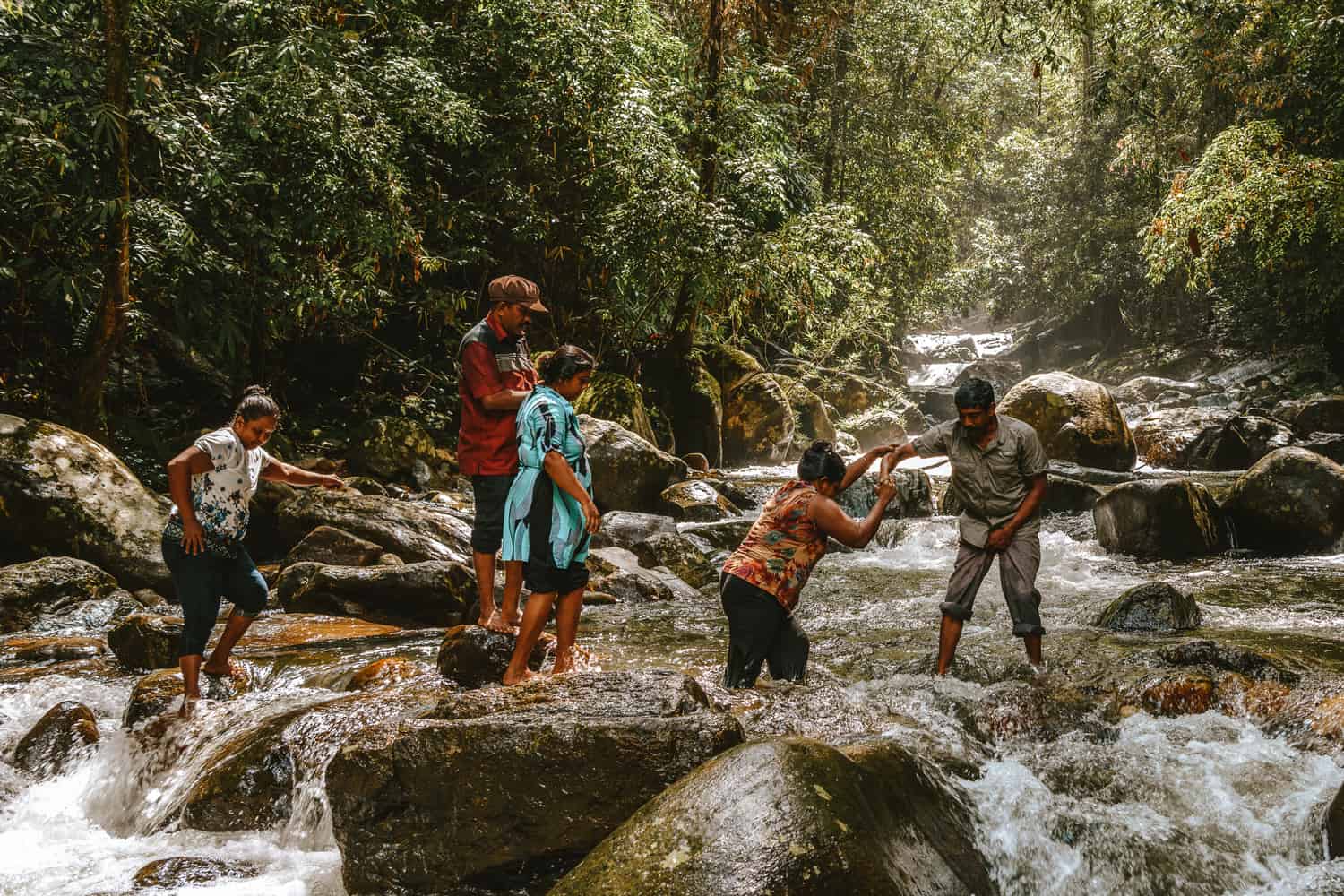
This 3-hour early morning trip inland could be slightly hectic, but a trek amidst the soothing natural sounds under the cooling canopy of this UNESCO Natural Site makes up for the logistical difficulties in traveling there from Galle.
If a day tour to Sinharaja from Galle comes across as too daunting for you, you could always opt to visit the Kanneliya Rainforest. Also called the KDN Forest Reserve, Kanneliya is said to be more biodiverse than Sinharaja and is home to endemic flora and fauna. Some of the highlights within this forest reservation are its waterfalls, including the Anagimala Waterfall, a giant Navanda (Scientific name: Shorea stipularis thwaites) tree, and a natural bat cave which you can traverse.
For me, the Navanda tree is a highlight; it is a still-remaining reminder of the original primary rainforest cover that the world was deprived of due to extensive logging in Kanneliya. The logging was brought to an end in 1988 and the forest reservation was established in 2004.
If you are travelling with kids, we recommend a trip to Kanneliya from Galle; this rainforest is closer to the city of departure and the trek is easier than that of the mighty Sinharaja.
10. Galle to Udawalawe: a day tour
A visit to the Udawalawe National Park promises you yet another close encounter with biodiversity and endemic species of flora and fauna on your Galle trip. One of the sights that this Park almost invariably offers is that of elephants.
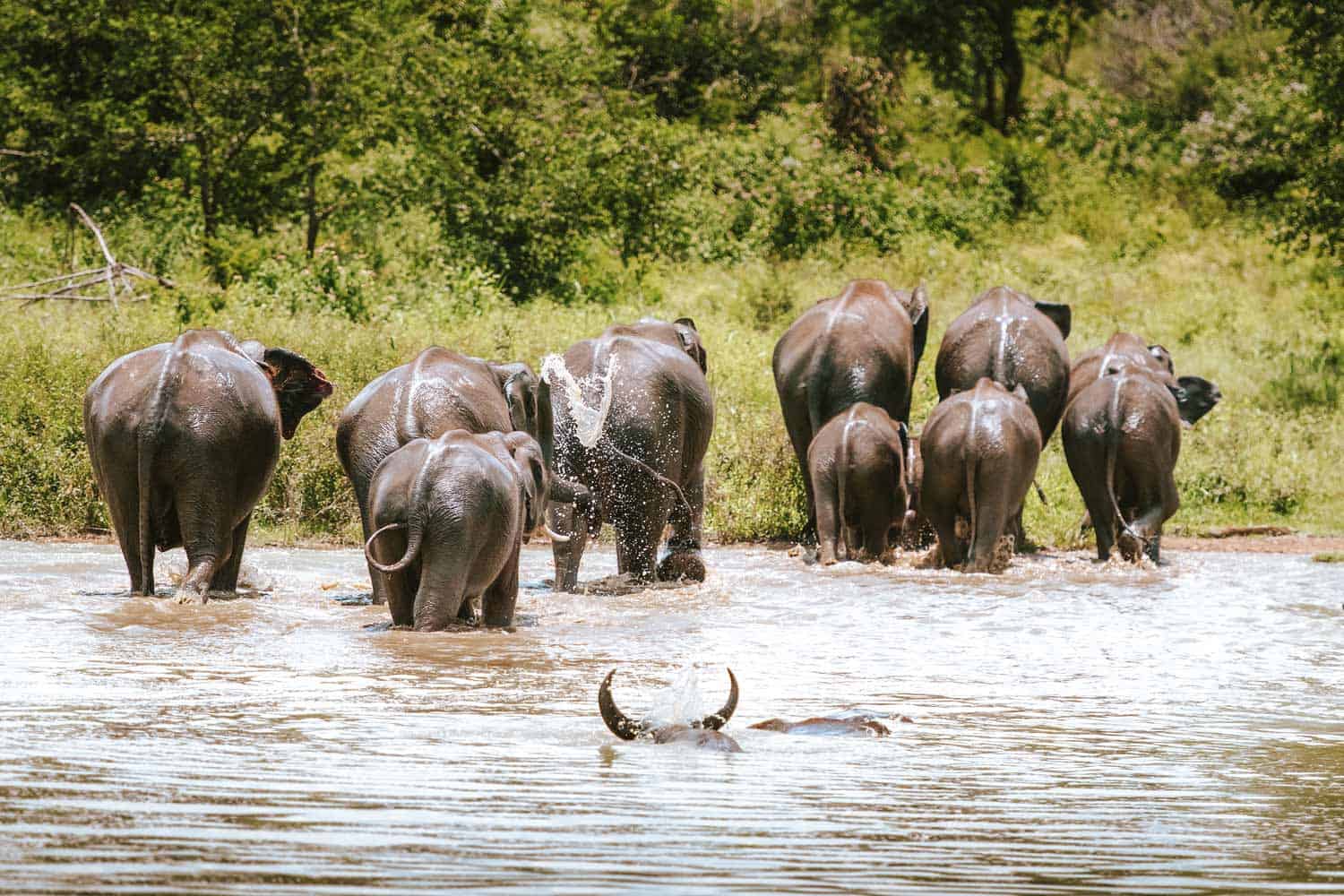
An estimated 500 gentle jumbos roam this national park, and the shrubs and small trees that characterize this terrain allows you to easily lay eyes on them! But, that is certainly not all; elephants are one of the 43 types of mammals that can be sighted in the park. Furthermore, Udawalawe offers the birdwatchers among you viewings of its diverse avifauna, which includes about 180 bird species.
Towards the northern border of the park are views of the silent yet mighty blue mountains of Sri Lanka's Central Highlands; the scenery is certainly a sight to behold!
Near the park entrance is located the Udawalawe Transit Home, which 'babysits' abandoned elephant calves. If you are visiting Sri Lanka with your children, a visit to this facility would be an enjoyable and memorable one, as was the case with the turtle hatcheries described earlier.
Summary
A Sri Lanka itinerary is certainly incomplete without an exploration of the wonder that is Galle. The city's present diversity and vibrance, along with its cultural significance, archaeological artifacts, newly introduced infrastructure, tall emerald waves and golden beaches make it a must-see, easily accessible tourist spot.
I hope this article inspires you to visit Galle and enjoy its many wonders. Feel free to drop your questions and share your thoughts in the comments below. I am looking forward to hearing from you.
Lastly, if you enjoyed this article, be sure to read some more. Perhaps our article "How to book train tickets in Sri Lanka" next?
Happy Travels!

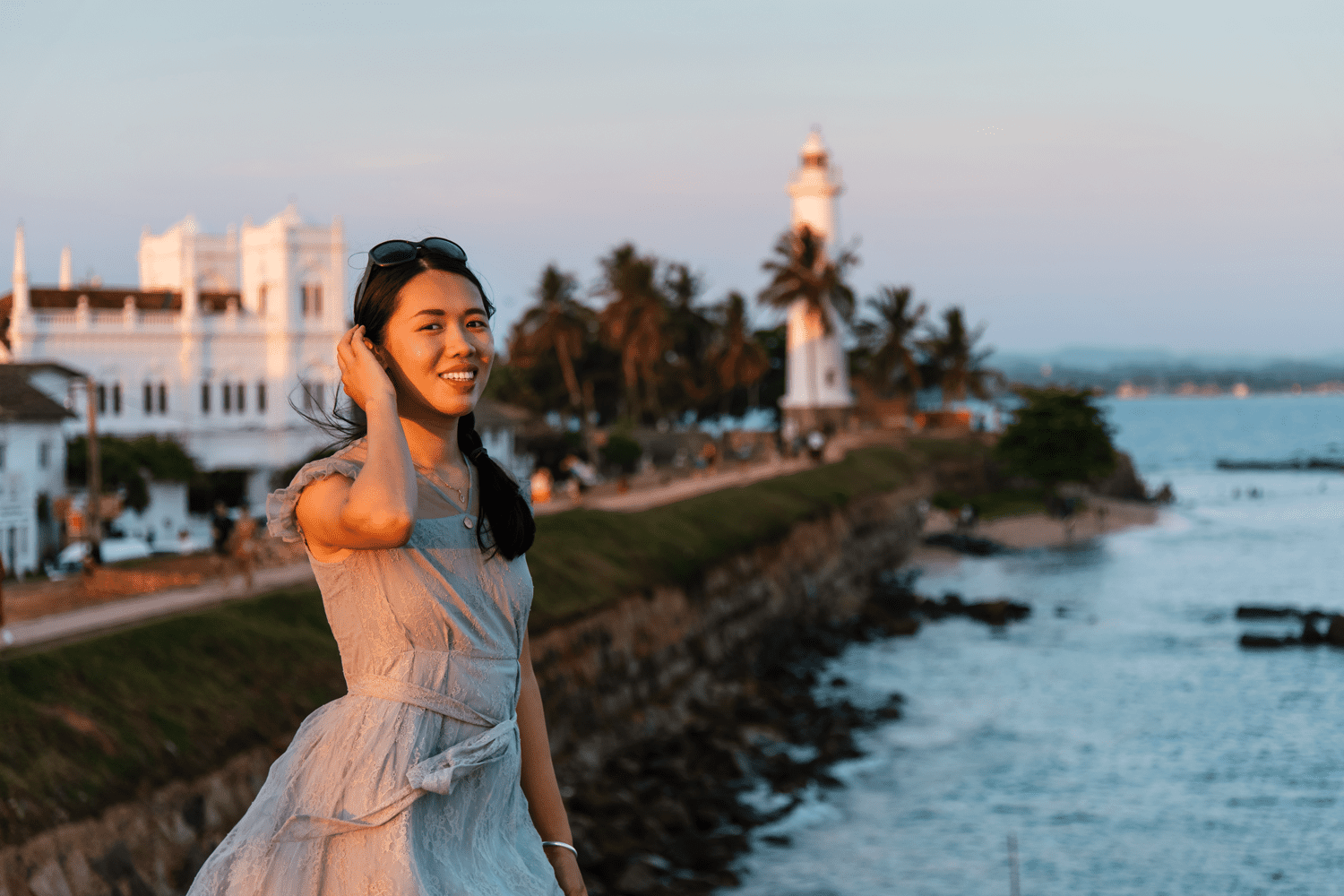
2 thoughts on “Top 10 things to do in Galle, Sri Lanka – Indepth guide”
Hi enjoyed very much your writing and all the tips, we are thinking of going to sri lanka, for 10 days (we are a couple in the fifties…) and thinking to go only to one area….beach…would you recommend Galle in August or other beach place….weather wise
Hi Sharon, the weather on the east coast of Sri Lanka would be better in August. So if you are visiting Sri Lanka just for a beach stay (in August), we recommend choosing Trincomalee, Nilaveli, Pasikuda or Arugam Bay for your oceanside stay.